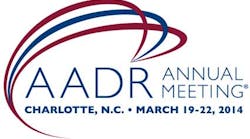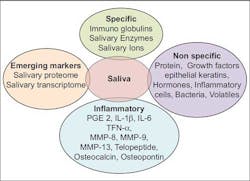Report from the 43rd Annual Meeting & Exhibition of the American Association for Dental Research
Gingivitis subjects had significantly higher bleeding on probing, plaque index and gingival index than healthy subjects. All gingivitis subjects showed a significant drop in bleeding on probing post-treatment, with 90% of subjects falling below 12% affected sites. Concentrations of MIP-1a and PGE2 were significantly higher in the gingivitis group than the healthy group. IL-1 was the only biomarker that showed a significant decrease in mean concentration after dental prophylaxis in the gingivitis group. Individuals with elevated levels of PGE2 +/- the other biomarkers were > 35.3X more likely to have gingivitis. These findings indicate that salivary PGE2 has the potential for discriminating gingivitis from health.(1) Patients who return to health clinically after dental prophylaxis appear to continue to produce inflammatory mediators for weeks. These findings have potential implications on the decision-making process in the developing area of personalized oral health care.
Water Fluoridation
A symposium entitled “Water Fluoridation: Safety Efficacy and Value in Oral Health Care” took place at the AADR meeting.(2) Community water fluoridation and other fluoride modalities have been used and proven for decades for the prevention and control of dental decay. There is widespread evidence on the efficacy and cost‐effectiveness of these interventions as well as assessments of the risks associated with fluoride ingestion.(3)
In 2006, the National Research Council identified severe fluorosis as the only known health effect of fluoride at 2-4 mg/L in drinking water.(4) Concentrations recommended for community water fluoridation (0.7 to 1.2 milligrams per liter) and current dosage schedules for other modalities ensure safety. Systematic reviews on fluorides have identified gaps in knowledge or the need to replicate some of the previous studies under current widespread use of fluorides. (2)
The learning objectives of this symposium were: the linkage between caries rates and water fluoridation; review of the research on the safety and value of water fluoridation; and understanding how community water is fluoridated. The learning objectives were addressed in the following four presentations: Effectiveness of Fluorides: Findings of Evidence-Based Reviews; The Health Assessment of Fluoride in Drinking Water: Conclusions from the National Research Council and Subsequent Scientific Assessments By EPA; Community Water Fluoridation: Translating Evidence into Public Health Practice; and Gaps in Scientific Knowledge Regarding Water Fluoridation and Other Fluoride Modalities.
Periodontal Regeneration
“Novel Pro-Resolving-Medicines in Periodontal Regeneration” was presented at the AADR meeting by Daniel Huy Nguyen from The Forsyth Institute.(5)
Uncontrolled host defense mechanisms can significantly impede tissue engineering, regeneration and reconstruction of oral and craniofacial tissues. The anti-inflammatory and pro-resolving actions of lipoxins and resolvins have already been documented in several preclinical models of inflammatory diseases including periodontal disease.(6)
The aim of this study was to evaluate the potential of Novel Pro-Resolving-Medicines (NPRMs) containing a lipoxin A4 (LXA4) analog in periodontal regeneration. Polymorphonuclear leukocyte-derived NPRMs were developed to deliver the LXA4-analog to the site of surgery for the purpose of controlling inflammation and promoting tissue and bone growth. An animal model of chronic periodontitis was surgically created and progressed into chronic periodontal infrabony defects. Sites were treated with reflection of mucoperiosteal flaps, debridement of the periodontal defect and placement of 1) control, 2) NPRM, 3) LXA4 analog, and 4) NPRM+LXA4 analog. The animals were followed for three months. Clinical evaluations of periodontal measures were obtained, and surgical sites analyzed.
Periodic clinical evaluations revealed that LXA4-analog treated groups exhibited complete wound healing with reduced inflammation when compared to control and NRPM-alone. All treatments showed significant pocket depth reductions without any statistical difference. A well-organized and newly formed interproximal bone close to the notch marked at surgery was found. Linear measurement of the distance between notch and bone crest in NPRM+LXA4 group revealed significant bone fill compared to control. Undecalcified sections demonstrated similar findings with new bone and new connective tissue formation at the NPRM+LXA4-treated sites. Further, micro-CT reconstruction of 3D morphology revealed complex anatomical structure and guided histological evaluation.
For photos of the lipoxin/resolvin process, see the Van Dyke article.(6)
References
1. Summary of abstract #834, “Salivary Biomarkers of Gingivitis: Information Important for Personalized Decision-Making,” presented on Friday, March 21, 2014, 10:45 a.m.-12:15 p.m. at the Charlotte Convention Center, room 203A.
2. Summary of symposium #111, “Water Fluoridation: Safety Efficacy and Value in Oral Health Care,” which will be presented on Friday, March 21, 2014, 10:45 a.m.-12:15 p.m. at the Charlotte Convention Center, room 217AB.
3. http://www.cdc.gov/fluoridation/benefits/.
4. http://www.nap.edu/catalog.php?record_id=11571.
5. Summary of abstract #755, “Novel Pro-Resolving-Medicines in Periodontal Regeneration,” which will be presented on Friday, March 21, 2014, 8 a.m.-9:30 a.m. at the Charlotte Convention Center, room 203A.
6. Mustafa M, Zarrough A, Bolstad AI, Lygre H, Mustafa K, Hasturk H, Serhan C, Kantarci A, Van Dyke TE. v Resolvin D1 protects periodontal ligament. Am J Physiol Cell Physiol. 2013 Sep 15;305(6):C673-9. doi: 10.1152/ajpcell.00242.2012. Epub 2013 Jul 17.
6. Van Dyke TE. The Management of Inflammation in Periodontal Disease. J Periodontol. 2008 August ; 79(8 Suppl): 1601–1608. http://www.ncbi.nlm.nih.gov/pmc/articles/PMC2563957/.
* http://www.luminexcorp.com/.
Additional reading
1. Sheilesh D, Van Dyke TE and Suzuki JB. Chronic inflammation in periodontal diseases: immunopathogenesis and treatment. http://www.dentistryiq.com/articles/gr/print/volume-2/issue-3/original-article/chronic-inflammation-in-periodontal-diseases-immunopathogenesis-and-treatment.html.









